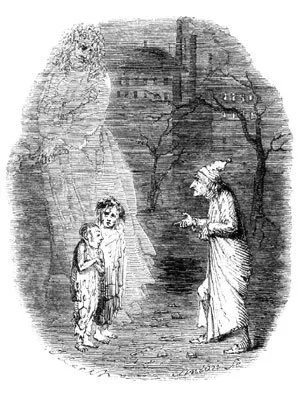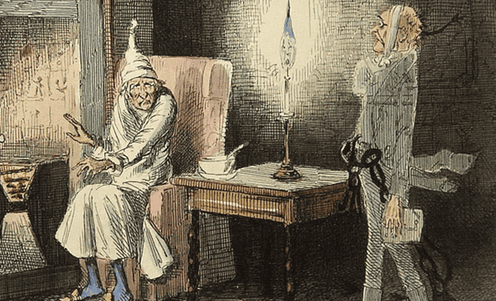Charles Dickens’s classic Christmas story, A Christmas Carol, was published on December 19, 1843. It’s the now-famous story of the conversion of a miserly man into a generous, kind person, who cares for the poor around him. At the beginning of the story, Ebenezer Scrooge, the miser of the story, is visited by the ghost of his dead business partner, Jacob Marley.
The book’s illustrations by John Leech, a British caricaturist, show the ghostly Marley with a cloth tied around his head. At one point in the story, Marley unwraps the cloth and his lower jaw falls.
Why was Jacob Marley’s head wrapped?

John Leech’s original illustration from A Christmas Carol.
Dickens never tells us what killed Jacob Marley, but some clues point to a toothache that led to a fatal infection.
The early 1840s was an age before antibiotics, an era when something as simple as a toothache could fester and become deadly. Most times, infected teeth were pulled, but the remaining root or resulting wound easily became infected. Or, if Marley were a smoker, as many men in Victorian England were, he might have developed oral cancer, leading to the deterioration of his jaw. Since both Marley and Scrooge were notorious misers, it’s safe to say that they were most likely too cheap to spend money on even rudimentary dental care of the type that was available in Victorian London.
It’s worth noting that the lack of dental care in Victorian England was not limited to the poor. Even the wealthy often neglected their teeth, and dental hygiene was not a priority. Toothbrushes were not widely used until the mid-19th century, and toothpaste was not commonly used until the 1850s. As a result, tooth decay and gum disease were rampant, and many people suffered from toothaches and other dental problems.
In fact, it was not uncommon for people to have all of their teeth extracted by the time they reached middle age and entirely replaced. Given the lack of dental care available at the time, it’s not surprising that Marley may have died from a toothache that led to a fatal infection. It’s a reminder of how far we’ve come in terms of dental care and how fortunate we are to have access to modern dentistry.
“Though [Scrooge] looked the phantom through and through, and saw it standing before him; though he felt the chilling influence of its death-cold eyes; and marked the very texture of the folded kerchief bound about its head and chin, which wrapper he had not observed before; he was still incredulous, and fought against his senses. But how much greater was his horror, when the phantom taking off the bandage round its head, as if it were too warm to wear in-doors, its lower jaw dropped down upon its breast!” (From A Christmas Carol)

Victorian pipe smokers in a drawing by S. Jenner circa 1850. REUTERS
In A Christmas Carol, Dickens shows us the reality of early Victorian Christmas – not the beautiful, snowy versions with children in sleighs and smoke emanating from cozy homes that we imagine, but the suffering of the poor, child labor and cold firesides. He urges us to use what we have to relive the suffering of others.
We may never find out why Marley wears that handkerchief to hold up his jaw, but we can enjoy the holidays, reread A Christmas Carol and marvel at the transformation of Scrooge from miserable miser to a man who embraces the good of the holiday season. Happy Holidays from the team at Benco Dental!
“…it was always said of him, that he knew how to keep Christmas well, if any man alive possessed the knowledge. May that be said of all of us! And so, as Tiny Tim observed, God Bless Us, Every One!” (From A Christmas Carol)


